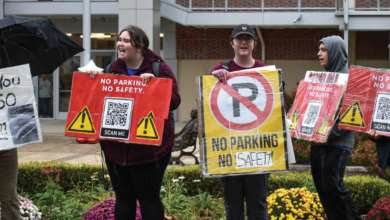
Administrator leads Zoom self-defense event for student organizations
By Tori Pender
An informative Zoom Self-Defense event for student organizations took place on Feb. 24 covering how to make sure virtual meetings are as secure as possible.
This event was held in response to the Zoom bombing attack that occurred on Feb. 11 during an event hosted by the Chi Alpha chapter of Zeta Phi Beta Sorority, Inc. and Tau Kappa chapter of Delta Sigma Theta Sorority, Inc.
“Rider University will not tolerate the hatred displayed during this event and will use every opportunity to engage all members of our community in actions that dismantle racism and other forms of marginalization,” said President Gregory Dell’Omo in a campus-wide email.
As of Feb. 28, there has been no update to the investigation of the aforementioned Zoom bombing.
The Zoom Self Defense event was run by Campus Life and the Office of Information Technologies (OIT).
Associate Dean of Campus Life Nicholas Barbati covered all of Zoom’s settings and Technical Support Coordinator Nick Karalexis provided a demonstration.
The first way to maximize safety is to use Zoom through Rider’s portal, Rider.zoom.us, as only Rider members have access.
Settings
Barbati explained that it is best for the host to have screen share abilities set only to themselves. If participants need to share their screen, the safest way is to individually give those users the role of alternate host.
In recent Zoom bombings, the agitators had taken over the annotate feature. This can be prevented in settings by changing the function to host only.
Waiting rooms are another recommended way to monitor the call before it begins; this ensures no one is in the meeting before the host is and allows the host to regulate attendees.
Registration
Lucia White, the coordinator of Campus Life, explained that student leaders must register events through the form on Bronc Nation. Once the event is approved, the registration links can then be created.
There are two different ways to have students register for events: Google Forms and Zoom registration.
The difference between the two is how the registration links are created. Zoom registration links create individual registration links, which would make kicking out an individual from the meeting easier. On the other hand, Google Form links give the same link to everyone who registers, meaning once you close that link, no one can come back into the event.
Within Zoom’s setting, Zoom registration will give anyone who registers the meeting link, unless it is altered in settings to allow the host to approve of each registration.
Promoting an event
Campus Life is advising that organizations stop displaying the actual Zoom meeting link and passwords on social media. Instead, they recommend to only make the registration link public, allowing club leaders to have more control. Another creative way to make the registration link available is through a QR code.
The safest place to publicly put the actual Zoom meeting link is Bronc Nation.
Barbati explained that it is because the site is password protected and limited to the Rider community.
“My immediate advice is to only post registration information on Rider Connect,” said Barbati. Opposed to displaying the meeting link, it allows organizations to have more control over who joins.
Similarly, Rider’s official pages will not be making Zoom links available for the public, only registration links.
During the event
Barbati recommended tasking other members with jobs to ensure that the Zoom event will run smoothly.
“There is likely an individual who is facilitating the program, so to please make sure that, that person is decided and that’s really for the functions of the program,” said Barbati. “However, like if you were having a program in the Bart Luedeke Center theater or the Yvonne theater we need individuals watching the door. And in the Zoom world, the door is the waiting room and the chat.”This would prevent the chat from becoming disruptive and it would allow for matters to be taken care of without involving the presenter, thus taking away from the meeting’s original intentions.
Another task involves someone monitoring the participant’s video feeds to ensure that all participants are behaving appropriately.
A feature that should be taken into consideration is the record feature.
Barbati said, “It can be helpful if an issue is arising or has arisen during the Zoom event and an investigation is necessary. That way if there are some questions, or what happened needs to be told, you immediately have a video that you can share with [Campus Life and OIT].”
Recorded videos from Zoom are exported once the Zoom call is finished and can be found on your computer or in the cloud, depending on an individual’s settings.
Barbati said, “Recording is not mandatory, if however, an emergency begins to arise within your event, we ask that you please hit record immediately if you are the host. That way we are able to catch all that is happening to be able to share with Public Safety.”
All participants must be made aware that a call is being recorded.
Stopping an incident
“In meeting controls, choose ‘security’ and then ‘suspend participant activities,’” explained Barbati.
This action locks the Zoom call. All features are suspended: video, audio, chat and screen share.
Barbati recommended that student leaders write down the agitator’s names, even if they are fake pseudonyms, along with the time the incident occurred.
After that, the host should proceed with Zoom’s reporting policy. Once a user is reported by the host using their security feature, a report is automatically sent to Zoom for them to review.
“Following the meeting with a Zoom intruder, it is vital to report the incident to OIT as well as Public Safety,” explained Barbati.
The next Zoom Event Security meeting for faculty, staff and students is scheduled for Thursday, March 11 at 10 a.m., registration links can be found in a campus-wide email sent by Douglas McCrea, associate vice president of OIT.


